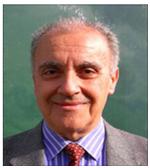


| Prof. Fabio Rocca |
 Biography:Fabio Rocca is Emeritus Professor of Telecommunications at the Politecnico di Milano. His research activities have been devoted to digital systems for telecommunications and bioengineering, seismic signal processing, and Synthetic Aperture Radar (since 1983). He is currently serving in the Mission Advisory Groups of the European Space Agency for the imaging radar satellites Sentinel 1 and BIOMASS, and in the Editorial Committee of the Journal Oil and Gas Science and Technology, Revue de l'Institut Français du Pétrole Energies nouvelles. Honorary Member of the Society of Exploration Geophysicists and of the European Association of Geoscientists and Engineers (EAGE). He received the Honeywell Award in 1979 for SPECT Tomography, the 1995 Italgas Award for Telecommunications, the 1999 Rhein Foundation (FRG) Technologies Award for the introduction of motion compensation in video coding. Doctorate Degree Honoris Causa (2001) in Geophysics from the Institut Polytechnique de Lorraine, Nancy. Desiderius Erasmus Award for lifetime achievements from the EAGE 2009. ENI Award 2012. In 2013 he received the Chinese Government International Science and Technology Cooperation Award. Biography:Fabio Rocca is Emeritus Professor of Telecommunications at the Politecnico di Milano. His research activities have been devoted to digital systems for telecommunications and bioengineering, seismic signal processing, and Synthetic Aperture Radar (since 1983). He is currently serving in the Mission Advisory Groups of the European Space Agency for the imaging radar satellites Sentinel 1 and BIOMASS, and in the Editorial Committee of the Journal Oil and Gas Science and Technology, Revue de l'Institut Français du Pétrole Energies nouvelles. Honorary Member of the Society of Exploration Geophysicists and of the European Association of Geoscientists and Engineers (EAGE). He received the Honeywell Award in 1979 for SPECT Tomography, the 1995 Italgas Award for Telecommunications, the 1999 Rhein Foundation (FRG) Technologies Award for the introduction of motion compensation in video coding. Doctorate Degree Honoris Causa (2001) in Geophysics from the Institut Polytechnique de Lorraine, Nancy. Desiderius Erasmus Award for lifetime achievements from the EAGE 2009. ENI Award 2012. In 2013 he received the Chinese Government International Science and Technology Cooperation Award.Title:An Advanced Radar Geosynchronous Observation System (ARGOS) Biography: A swarm of N SAR sensors, both transmitting and receiving, in a geostationary orbit, might provide all-day-all-weather imaging within a continental region, using direct downloading for real time data exploitation. The coherent combinations of all the echoes would improve the signal-to-noise ratio by a factor of N², leading to metric resolution, 20 - 40 minutes minimum observation time, multi-polarimetric and interferometric imaging. Fast evolving events like landslides, floods, soil moisture changes, volcanic activity, co-seismic motions, infrastructure deformations and columnar water-vapour maps could be monitored continuously from space for the first time. The observed area could have a footprint from hundreds to a thousand kilometres wide, according to the resolution, settable using electronic steering, anytime, anywhere within a continent, and a flexible access that can span from the south to the north hemisphere. Two structures of constellation have been conceived: one is an evolution of the Massonnet cartwheel. The satellites are seen from the ground as oscillating along a line on the equator. The ever changing position of the N satellites and of their N(N-1)/2 midpoints (the bistatic centers) would sample the real antenna quasi uniformly with time. In the alternate structure, each satellite would oscillate on a different position along the equator. The collective pattern would not change with time, but it would itself librate. Thus, a shorter antenna would oscillate along the equator with the hour of the day, so that a short term low resolution image would expand during the 12 hours cycle to a wider resolution system. The flexibility of the reconfigurable swarm, characterized anyway by a gentle degradation in case of failures, and the consequent observation parameters, could be used to customize the system for the applications of interest |